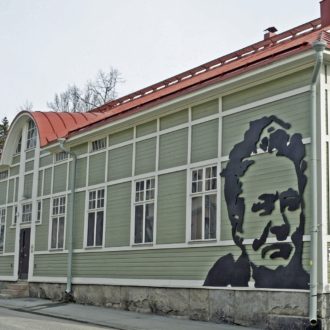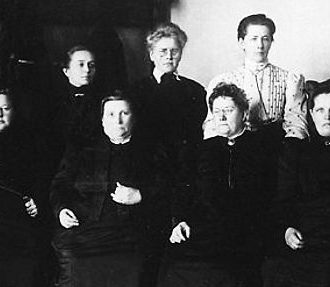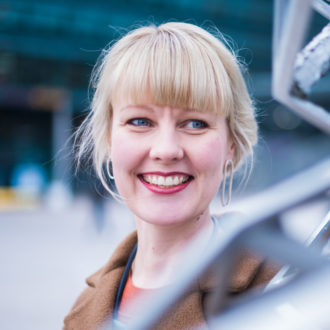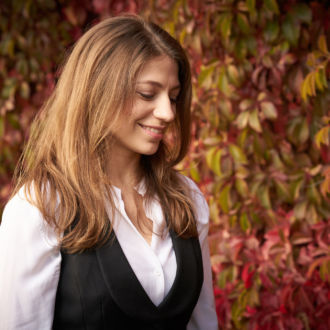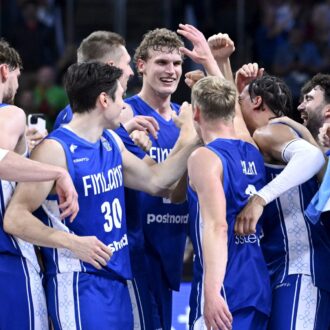Gender equality remains a crucial issue all over the world. For people in Finland, it has been an important guiding principle for a long time.
In 1906, Finland became the first country in the world to grant full political rights to women – both the right to vote (a first in Europe) and the right to run for office. As of March 2024, 12 out of 19 government ministers are women, as are 92 out of 200 members of Parliament (46 percent).
Our list shows some of the women who paved the way for others, as well as some who benefited from those earlier efforts and continue to make progress today. They, in turn, serve as inspiring examples for the next generation.
The list below is admittedly incomplete – if we included everyone who deserves it, there would be millions of women in this article.
Tove Jansson (and Little My)
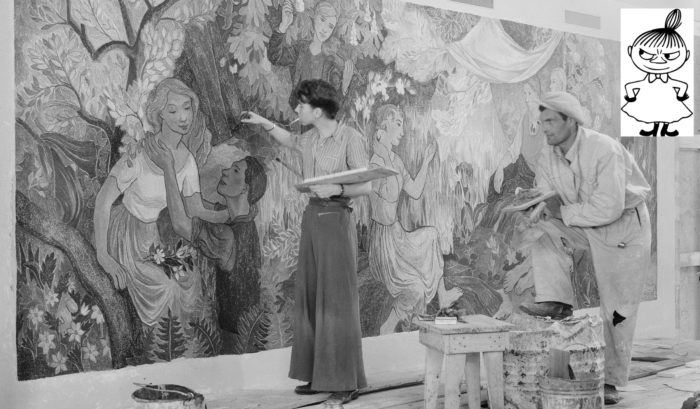
Tove Jansson works on Party in the Country (1947), a fresco now on display at Helsinki Art Museum, while Niilo Suihko, who was assisting her, looks on. Inset: Little My is a Moomin character who is tiny but fears nothing.Photo: Foto Roos/Helsinki Art Museum; illustration: Tove Jansson/Moomin Characters Ltd
Author and artist Tove Jansson (1914–2001) is best known as the creator of the Moomins, the fun and philosophical characters who inhabit nine novels and numerous picture books, comic strips and animated films. Having written and illustrated the Moomin books, which now appear in more than 50 languages, Jansson is probably Finland’s most famous artist and its most famous author. She also wrote other novels and short stories and had a prolific career as an illustrator and painter. Jansson wrote in Swedish, which is one of Finland’s official languages.
Part of the Moomins’ popularity stems from the way they reflect human characteristics, often humorously, sometimes reminding readers of people they know in real life. One female Moomin character who belongs on this list is Little My. Although tiny, she fears nothing. In one book she dares to go ice-skating on the frozen sea; in another, she bites a lion on the leg. She always speaks her mind, assessing situations with brutal honesty, and while that makes her seem cross, it has also made her a favourite among Moomin fans.
In many ways, Jansson herself chose a bold way of life. For a time, she lived with a man without being married, against the social norms of the day. She had relationships with women, a punishable offence in mid-20th-century Finland. In recent years, the queer and feminist communities have drawn deserved attention to this part of Jansson’s legacy.
Sanna Marin
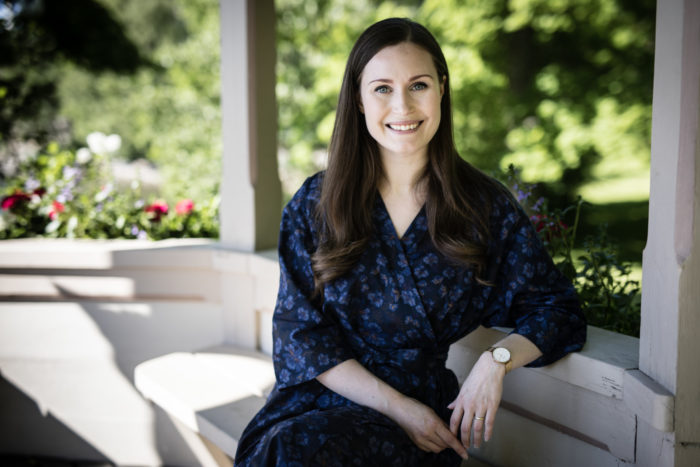
Sanna Marin took office shortly after her 34th birthday, becoming Finland’s youngest prime minister ever.Photo: Laura Kotila/Prime Minister’s Office
Sanna Marin (born in 1985) attracted attention when she took office as prime minister in December 2019, less than a month after her 34th birthday. At the time, she was the world’s youngest serving prime minister, and she was the youngest one in Finnish history. She was the country’s third female prime minister. It didn’t escape the media’s notice that the other four parties in the government coalition had women leaders. Her term in office lasted until June 20, 2023.
In an article about Marin in April 2020, Vogue’s American edition wrote that Finland “punches above its weight in terms of soft power – the egalitarianism, family benefits, and forward-thinking environmentalism that Marin embodies.” At that point, Finland’s experience in counteracting the coronavirus was just beginning.
In February 2021, TIME magazine featured Marin in its TIME100 Next list of “emerging leaders from around the world who are shaping the future.”
Armi Ratia
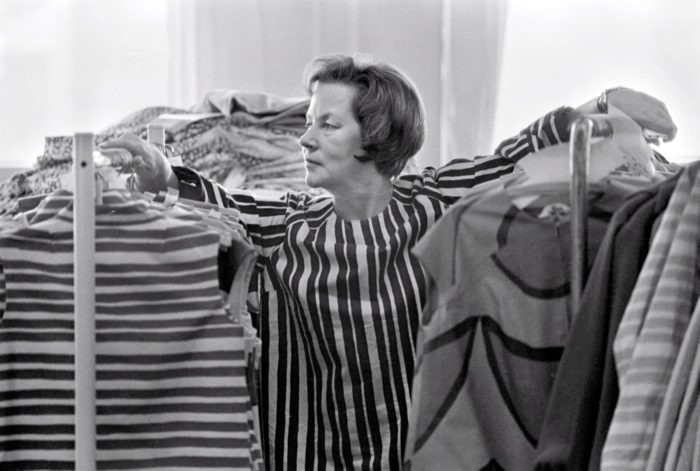
Armi Ratia founded the textile design company Marimekko and succeeded in making its patterns internationally famous.Photo: Gustav Wahlsten/Lehtikuva
In a 1976 documentary, an interviewer asks Armi Ratia, “Where did you get the idea and the courage to go abroad?” She answers, “You can be born with courage, or you can become courageous out of necessity.” She doesn’t specify which option applies to her.
Ratia (1912–1979) founded Marimekko, a textile design company whose prints and clothes became famous all over the world. “I’m interested in things that are new and unexpected,” she says in the documentary. “Impossible things, especially, and difficult things.”
As it turns out, it wasn’t impossible for Ratia and Marimekko to succeed internationally. Jacqueline Kennedy famously wore Marimekko dresses, and many of the company’s classic patterned textiles have become iconic and are still in production today.
Tarja Halonen
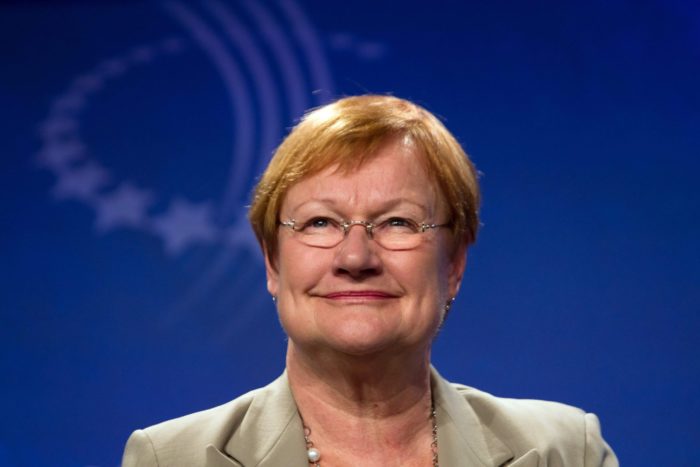
President Tarja Halonen of Finland attends a meeting of the Clinton Global Initiative in New York in 2011.Photo: Daniel Berehulak/Getty Images/AFP/Lehtikuva
Finland’s first female president, Tarja Halonen (born in 1943) held the position for two six-year terms, from 2000 to 2012. Prior to that, she was a member of Parliament for 21 years and served in several ministerial posts. Earlier she had worked as a lawyer at the Central Organisation of Finnish Trade Unions.
At one point in her first presidential term, polling showed an 88 percent approval rating. She had good ratings across geographic regions and demographic groups. Throughout her career, Halonen has sought to strengthen workers’ rights and the rights of many different minorities. Sustainable development has been another focus. She has served in a number of nongovernmental organisations for causes she believes in.
In 2015 Halonen had a fellowship at the Harvard Kennedy School. She’s a member of the Council of Women World Leaders, serves on the UN Secretary-General’s High-Level Advisory Board on Mediation and cochairs the UN High-Level Task Force for the International Conference on Population and Development.
Linda Liukas
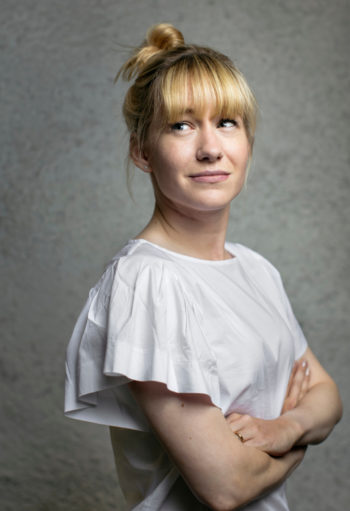
Author and educator Linda Liukas demystifies coding, technology and the internet for children – and for grown-ups, too.Photo: Maija Tammi
With her series of children’s books, Hello Ruby, Linda Liukas (born in 1986) encourages kids to learn about coding, technology and the internet. The books, which she wrote and illustrated, appear in more than 20 languages. She is also the cofounder of Rails Girls, which arranges events that get girls interested in technology and coding.
She participates as a consultant in scholastic programmes all over the world, and has appeared at numerous tech companies and conferences, talking to audiences about demystifying and navigating the world of computers. You can catch her TED talks and some of her other speaking gigs on YouTube.
Alma
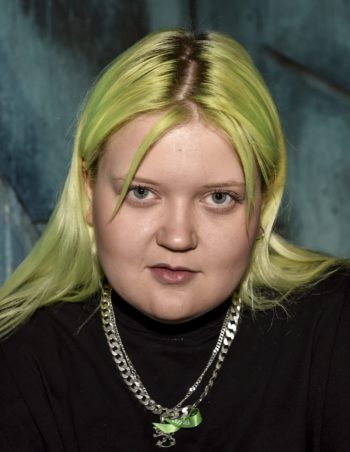
Alma’s performance on Finnish Idols in 2013 set the stage for her breakthrough as a singer.Photo: Emmi Korhonen/Lehtikuva
Singer Alma-Sofia Miettinen (born in 1996) goes by the stage name Alma and first gained prominence as a contestant on Finnish Idols in 2013. Recording deals and collaborations with other artists followed, as did a solo album entitled Have U Seen Her? in 2020. She cowrote the song “Don’t Call Me Angel,” the theme of the 2019 movie Charlie’s Angels, and sings on another of the film’s songs, “How It’s Done.”
In 2020, when the annual Helsinki Day (June 12) celebrations moved online because of coronavirus-related restrictions, Alma gave a concert in a virtual reality version of the Finnish capital. Audience members could participate as avatars in the VR world.
Susanna Mälkki
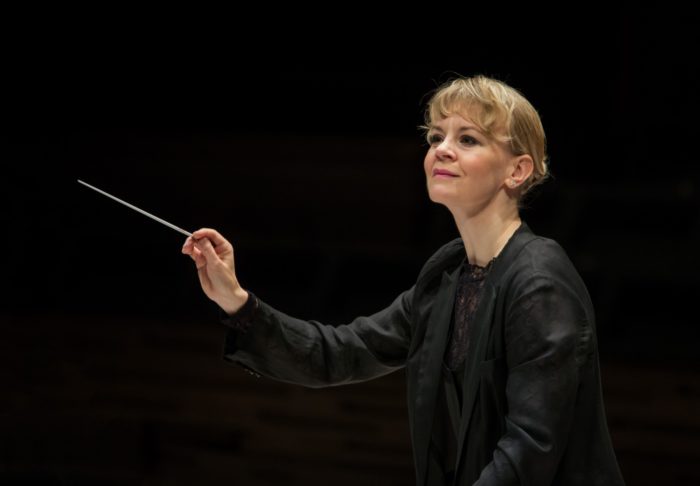
World-renowned conductor Susanna Mälkki has pointed out that, as recently as the 1990s, conducting was not considered a serious option for women. She did not let that stop her.Photo: Sakari Viika/Helsinki Philharmonic Orchestra
Conductor Susanna Mälkki (born in 1969) became the first-ever female chief conductor of the Helsinki Philharmonic Orchestra in 2016. She has conducted the London Philharmonic, the BBC Symphony and the New York Philharmonic.
Earlier in her career, she concentrated mainly on playing the cello. In an interview with the New York Times in 2016, she pointed out that things were very different as recently as the early 1990s. Conducting was not seen as an option for women. “I was always interested in conducting,” she told the Times. “But of course there are historical reasons why I was hesitant at the beginning.”
The situation changed. In the late 1990s, Mälkki pivoted from the cello to conducting. Music Finland’s website calls her “a champion of bold contemporary composers.” In the same article, she says, “It’s true that twentieth-century and contemporary music is what I’m best known for. But I’d like to think of myself as someone who can do both, as I always have.”
Awak Kuier
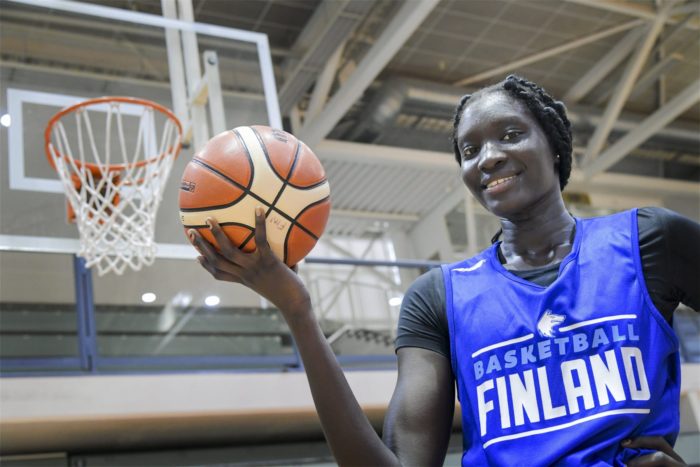
Basketball star Awak Kuier takes a break between drills during a Finnish national team practice in summer 2020.Photo: Markku Ulander/Lehtikuva
Basketball player Awak Kuier (born in 2001) grew up in the southern Finnish town of Kotka. In her late teens, her family relocated to the Helsinki area so she could attend Mäkelänrinne Sports High School, where the schedule helps players keep up in both academics and sports.
Kuier debuted on the Finnish national team at the age of 16. She played for Virtus Eirene Ragusa, a leading team in Italy’s top division, before being drafted by the Dallas Wings of the WNBA in the US. She was the second pick overall in the 2021 draft, and was the first Finnish player to play in the WNBA when she stepped onto the court in May 2021.
She exceeded her own expectations: After signing the Italian contract in the summer of 2020, Kuier had told Finnish national broadcaster Yle, “I believe I can develop there and go very far.” As far as North America is concerned, she said at the time, “My personal goal is to be ready for the WNBA in two years.”
Enni Rukajärvi
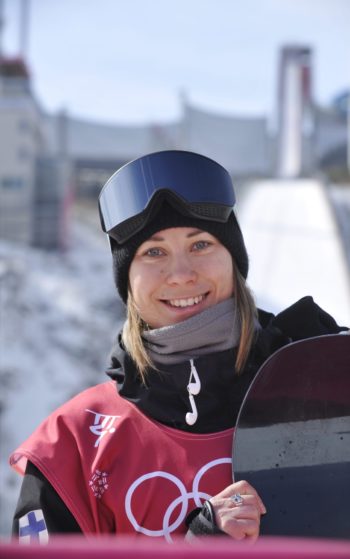
Enni Rukajärvi would like to use the publicity she gets as a world champion snowboarder to highlight environmental protection and other causes. She has become an ambassador for the Protect Our Winters organisation.Photo: Timo Jaakonaho/Lehtikuva
Finnish people are wild about winter sports, and snowboarder Enni Rukajärvi (born in 1990) has given fans many reasons to cheer. Specialising in the slopestyle event, in which the ski hill includes built-in obstacles such as jumps and rails, Rukajärvi has medalled at the Winter X Games four times (one gold, one silver and two bronzes). She took silver in slopestyle at the 2014 Winter Olympics and bronze in 2018. At the world championships, she has won gold in slopestyle and silver in big air, an event that involves performing airborne tricks after going off a jump.
Rukajärvi has said that she tries to use the publicity she gets as an athlete to draw attention to worthy causes such as safeguarding the environment. She’s an ambassador for Protect Our Winters, an organisation that campaigns and raises awareness in order to save winter – and winter sports – from climate change.
In a December 2020 article in Helsingin Sanomat, Finland’s largest daily, Rukajärvi expressed admiration for the younger generation in her sport. She said that the new kids are doing jumps and tricks in their mid-teens that she didn’t do until she was 19 or 20. We believe that she must have been at least partly responsible for inspiring those kids.
Helene Schjerfbeck
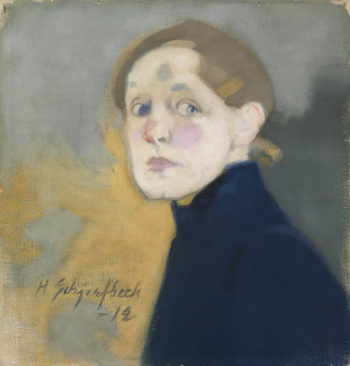
Helene Schjerfbeck is famous for her self-portraits, including this one from 1912, which appeared in an exhibition in late 2019 and early 2020 that broke attendance records at the Ateneum Art Museum in Helsinki.Photo: Hannu Aaltonen/Ateneum Art Museum/Finnish National Gallery
Artist Helene Schjerfbeck (1862–1946) has at times been overshadowed by her male contemporaries. She shouldn’t be, and in recent years new audiences have discovered the appeal of her work.
Anna-Maria von Bonsdorff curated a pre-corona exhibition of Schjerfbeck’s paintings at Helsinki’s Ateneum Art Museum. It attained the highest average daily visitor count of any show in the museum’s history. “She seems somehow contemporary,” von Bonsdorff tells ThisisFINLAND. “Her use of popular materials appeals to younger audiences.” Von Bonsdorff says that Schjerfbeck is considered Finland’s number one painter.
By the way, the “schj” at the beginning of her name is pronounced like “sh” in English. (It’s not a Finnish-language name; Schjerfbeck’s first language was Swedish, which is still one of Finland’s official languages.)
Minna Canth
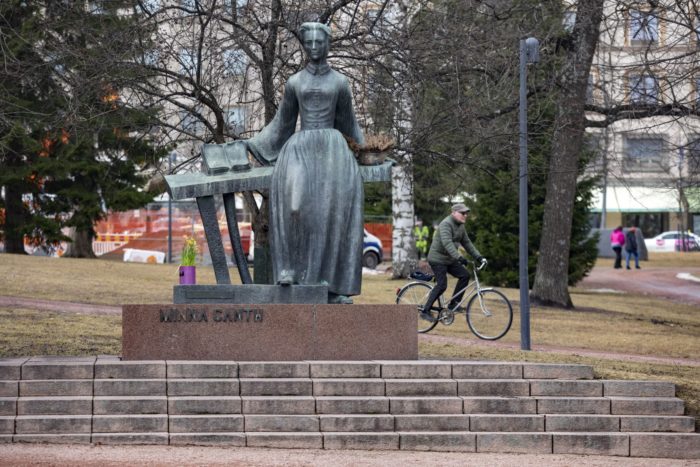
Many consider author Minna Canth (1844–97) Finland’s first feminist. This statue in her honour stands in the central Finnish city of Jyväskylä.Photo: Tommi Anttonen/Comida Communications/Lehtikuva
Widely acknowledged as Finland’s first significant female author, Minna Canth (1844–97) wrote short stories, novellas, plays and articles. She received admiration for representing women realistically and questioning the patriarchal norms that limited their opportunities. Canth championed women’s rights, feminism and social causes.
“In a way, she was Finland’s first feminist,” says Minna Rytisalo, a teacher and the author of a biographical novel about Canth. “She believed that girls should have the right to an education…to learn about things like science, nature and the economy.”
While Finland has taken huge steps towards achieving gender equality since Canth’s time, she remains relevant. “Rights are never written in stone,” Rytisalo says. “Establishing a right doesn’t guarantee [it] forever.”
Canth’s legacy has inspired generations of feminist writing in Finland. Rytisalo says that we can all learn from Canth’s attitude: “She believed in doing your own thing and knowing in your heart that it is the right thing to do, even when the world says it’s not.”
Maryan Adbulkarim
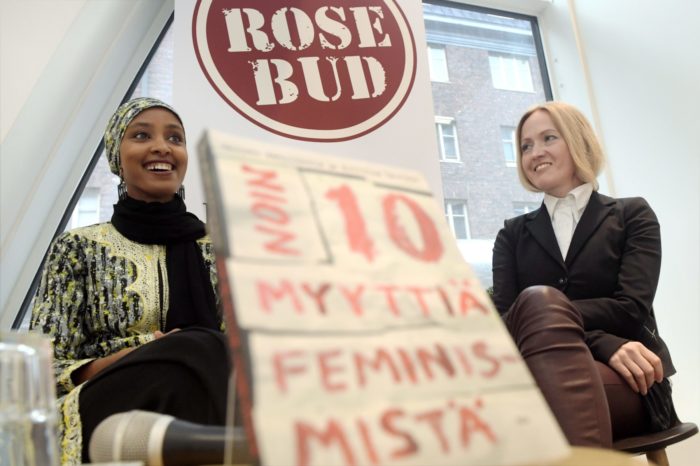
Coauthors Maryan Abdulkarim (left) and Eveliina Talvitie at the release of their book Noin 10 myyttiä feminismistä (Approximately Ten Myths about Feminism) in 2018.Photo: Vesa Moilanen/Lehtikuva
Born in 1982, Maryan Abdulkarim is an award-winning writer, journalist and feminist who grew up in the central western Finnish city of Tampere. In 2019, she received the Minna Canth Award, presented by the Finnish Fair Foundation to a person who “shakes up our society.”
The jury called her “courageous in writing and conversing about society,” and said she “tirelessly sticks up for women and minorities and shines light on inequality.” In 2021, she received the Helsinki Medal for work that has helped the capital become more aware of the changes a diversifying city requires. (Abdulkarim has also written for ThisisFINLAND.)
Miina Sillanpää
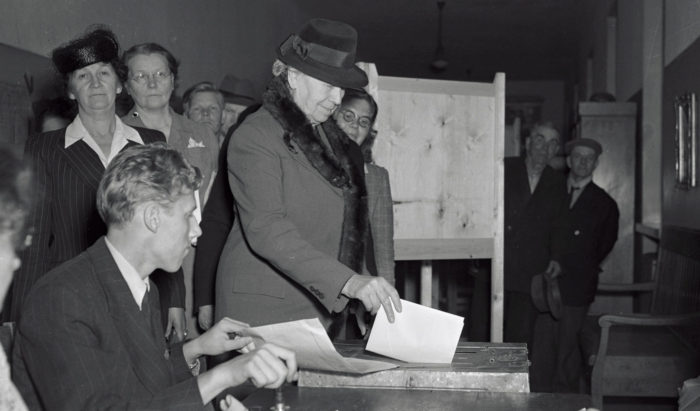
Member of Parliament Miina Sillanpää, who was also Finland’s first female government minister, casts her vote at a polling station during parliamentary elections in 1948, the year she retired from Parliament.Photo: Osvald Hedenström/Hede-Foto/Lehtikuva
Born into poverty, Miina Sillanpää (1866–1952) grew up to become a member of Parliament and Finland’s first female government minister. She spent much of her life engaged in civil activism and social advocacy, helping the cause of women, the elderly and the disadvantaged, motivated by her values of fairness and equality.
She was active in the drive for women’s suffrage in the early 1900s, and after women in Finland gained the right to vote and to stand for election, in 1906, she was among the first 19 women elected to Parliament, in 1907. She was an MP for 38 years; from 1926 to 1927 she served as minister of social affairs.
In 1898 she helped found the Servants’ Association, taking over as director in 1901. In the 1930s, she took part in starting an organisation of shelters for single women and their children, overcoming longtime cultural resistance to the idea.
Meeri Koutaniemi
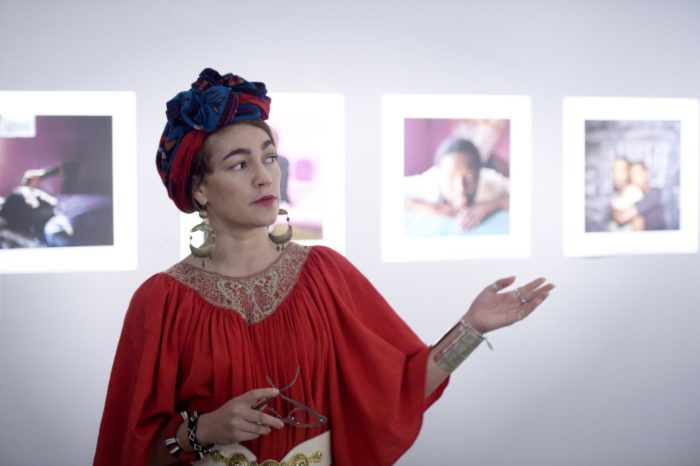
In 2015, Meeri Koutaniemi took part in the exhibition To the Third Generation, part of the Festival of Political Photography, at the Finnish Museum of Photography.Photo Martti Kainulainen/Lehtikuva
Photographer and journalist Meeri Koutaniemi (born in 1987), has travelled to dozens of countries to document “compelling stories of struggle and resilience,” as she says on her website. She has been named Press Photographer of the Year twice in Finland and has received numerous other awards there and abroad. Her work focuses on the “humanitarian side of conflicts, displacement and discrimination,” she says.
Koutaniemi’s subjects have included Syrian refugees who have escaped across the border; Rohingya refugees from Myanmar; Chechen refugees in Finland; the unique dress style of the Herero people of southern Africa; HIV-positive transsexuals in Mexico; girls’ fate in a rural Kenyan culture that practices female genital mutilation; and Uganda’s progress in stopping the practice.
Kaija Saariaho
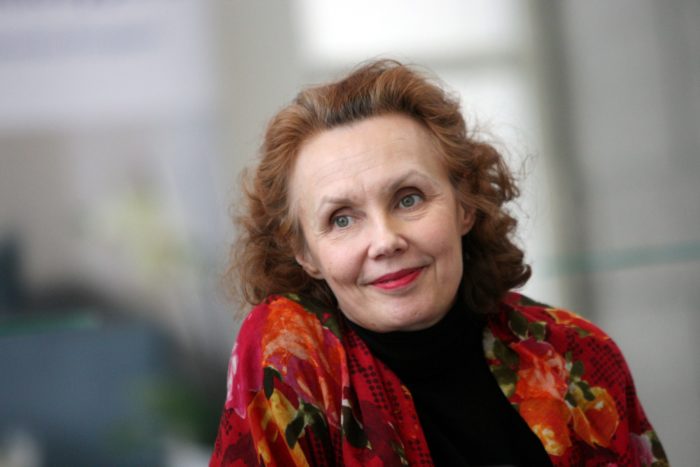
Kaija Saariaho is Finland’s most famous modern composer of classical music. In 2019, BBC Music magazine called her the greatest living composer in the world.Photo: Jussi Nukari/Lehtikuva
A composer of classical music, Kaija Saariaho (1952–2023) created pieces on commission for numerous ensembles, including the Kronos Quartet, the New York Philharmonic and the Finnish National Opera. Her composition L’amour de loin won a Grammy for Best Opera Recording in 2011. She has also received the Wihuri Foundation’s Sibelius Prize, the Polar Music Prize, the Nordic Council Music Prize, the Prix Ars Electronica, the BBVA Foundation Frontiers of Knowledge Award and many others.
So how do you describe Saariaho’s music? She has used computer analysis in creating musical structures, has included electronic music in her pieces and merges the visual world with the musical world. Writing about her opera Adriana Mater, in the New Yorker, in 2006, Alex Ross put it like this: “Instruments cry out at high or low extremes; pitches are bent or broken apart; violins are bowed with such intensity that they groan…It’s the kind of sound that boxes the ears and maxes out the brain; information pours in on all frequencies.”
However, in the following sentence, he added that “her pieces often bring apparitions of rare, pure beauty.”
By ThisisFINLAND staff, March 2021, updated March 2024
